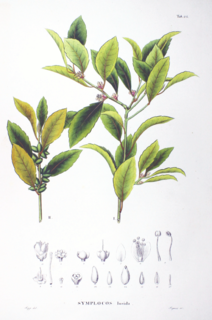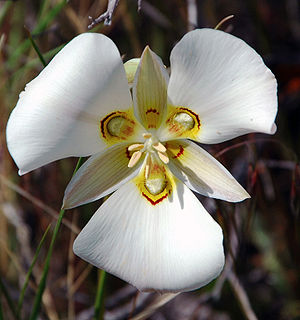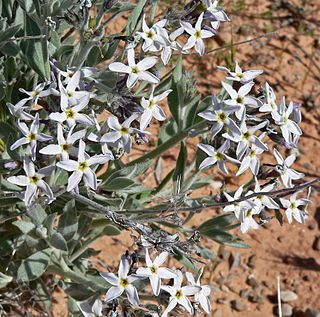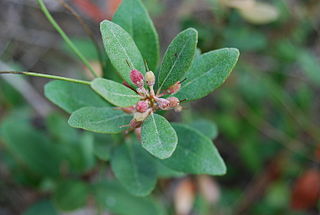
Brazoria County is a county in the U.S. state of Texas. As of the 2020 census, the population of the county was 372,031. The county seat is Angleton.

Lake Jackson is a city in Brazoria County, Texas, United States, within the Greater Houston metropolitan area. As of the 2020 census, the city population was 28,177.

Schlumbergera is a small genus of cacti with six to nine species found in the coastal mountains of south-eastern Brazil. These plants grow on trees or rocks in habitats that are generally shady with high humidity, and can be quite different in appearance from their desert-dwelling cousins. Most species of Schlumbergera have stems which resemble leaf-like pads joined one to the other and flowers which appear from areoles at the joints and tips of the stems. Two species have cylindrical stems more similar to other cacti. Recent phylogenetic studies using DNA have led to three species of the related genus Hatiora being transferred into Schlumbergera, though this change is not universally accepted.

Agave parryi, known as Parry's agave or mescal agave, is a flowering plant in the family Asparagaceae, subfamily Agavoideae. It is a slow-growing succulent perennial native to Arizona, New Mexico, and northern Mexico.

Allium canadense, the Canada onion, Canadian garlic, wild garlic, meadow garlic and wild onion is a perennial plant native to eastern North America from Texas to Florida to New Brunswick to Montana. The species is also cultivated in other regions as an ornamental and as a garden culinary herb. The plant is also reportedly naturalized in Cuba.

Haworthia is a large genus of small succulent plants endemic to Southern Africa (Mozambique, Namibia, Lesotho, Eswatini and South Africa).

Eryngium yuccifolium, known as rattlesnake master, button eryngo, and button snake-root, is a perennial herb of the parsley family native to the tallgrass prairies of central and eastern North America. It grows from Minnesota east to Ohio and south to Texas and Florida, including a few spots in Connecticut, New Jersey, Maryland, and Delaware.

Symplocos is a genus of flowering plants in the order Ericales. It contains about 300 species distributed in Asia and the Americas. Many species grow in humid tropical regions. This is sometimes considered to be the only genus in family Symplocaceae. Plants in this family are shrubs and trees with white or yellow flowers.

Calochortus nuttallii, also known as the sego lily, is a bulbous perennial plant that is endemic to the Western United States. It is the state flower of Utah.

Symphyotrichum lateriflorum is a species of flowering plant in the aster family (Asteraceae). Commonly known as calico aster, starved aster, and white woodland aster, it is native to eastern and central North America. It is a perennial and herbaceous plant that may reach heights up to 120 centimeters and widths up to 30 cm (1 ft).

Amsonia tomentosa is a species of flowering plant native to the southwestern United States and northern Mexico (Chihuahua). Its common names include woolly bluestar and gray amsonia.

Telopea truncata, commonly known as the Tasmanian waratah, is a plant in the family Proteaceae. It is endemic to Tasmania where it is found on moist acidic soils at altitudes of 600 to 1200 m (2000–4000 ft). Telopea truncata is a component of alpine eucalypt forest, rainforest and scrub communities. It grows as a multistemmed shrub to a height of 3 metres (10 ft), or occasionally as a small tree to 10 m (35 ft) high, with red flower heads, known as inflorescences, appearing over the Tasmanian summer and bearing 10 to 35 individual flowers. Yellow-flowered forms are occasionally seen, but do not form a population distinct from the rest of the species.

Sceptridium dissectum is a common fern in the family Ophioglossaceae, occurring in eastern North America. Like other plants in this group, it normally only sends up one frond per year. It has long been the subject of confusion because the frond presents in one of two forms, either the normal form that resembles other plants in the genus, or the skeletonized form.

Pluchea odorata is a species of flowering plant in the aster family, Asteraceae. Common names include sweetscent, saltmarsh fleabane and shrubby camphorweed.

Lyonia truncata is a species of flowering plant in the family Ericaceae known as Dominican staggerbush.

Haworthia truncata, locally known as horse's teeth, is a species of succulent plant in the genus Haworthia. It is found in the Little Karoo region, in the far east of the Western Cape Province, South Africa.
This is a list of plants and how they are used in Zuni culture.

Brazoria is a genus of plants in the family Lamiaceae, first described in 1845. It contains three known species, all endemic to the US state of Texas.
Helianthus praecox is a North American species of sunflower known by the common name Texas sunflower. It is endemic to Texas. Most of the populations are either along the Gulf Coast or in the Río Grande Valley.

Strumaria truncata is a species of flowering plant in the family Amaryllidaceae, native to the Cape Provinces of South Africa. It is widely distributed in the northwest of the Cape Provinces, and the most common of the Strumaria species found there. It forms small clumps of bulbs which produce twisted leaves. Its flowers, which are pendulous, vary in colour from white to deep pink. The pink forms were once treated as a separate species, Strumaria rubella, and have also been called var. rubella. The species was first described by Nikolaus Joseph von Jacquin in 1792.


















